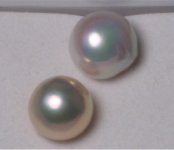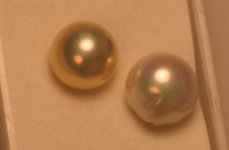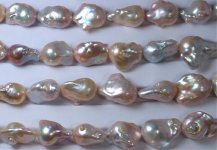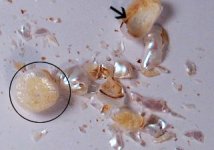I was in Inhorgenta and then I had forgotten the password

confused

, so I have delayed to reply the above message.
Jeremy, you are right that the circled material is bead and arrow shows the outlayer. I have checked it again and think that the bead is probably also a pearl as you, which has probably been processed before nucleation. It is a natural thought to insert a pearl into the mussel because they are cheap and accessible as well as have the same composition. Any way, I think that the pearls are bead-nucleated, but I can not prove which beads are used. Beads can have button form. Some try to produce bead-nucleated ?mabe? pearls (I had some, which are really half pearls). If you are interesting at it, tell me your address. I can send you some pearls in the above picture for check.
In order to explain which beads are used in new fresh water pearls. I have spent some time to collect the information and to ensure that they are correct, I have called some bosses and common people in the bead factories. The beads in China are produced in a community in Province Jiangxi. They claimed that they produce 95% of the beads in China and one factory produces alone about 75%. They have also about 70% of bead market for SSP and Tahiti.
The most used materials for beads are mussels from Mississippi river and the wild mussels from Po Yang Lake (one of the largest three lakes in China). The beads with Chinese wild mussels can be larger than 10 mm and have been exported to other countries for Tahiti and SSP. One can see some pictures with the link
http://cp.legoo.com/dh/10/1477/. The left lowest picture shows some beads produced with mussels from Mississippi and Po Yang Lake for Tahiti. The mussels used to produce the pearls can not be used for large beads.
I have clearly asked whether the shell of gigantic clams has been used in the production of beads. They told me that the factories in that community (which produces 95% of beads in China) do not use that shell now to produce beads. The causes are that the death rate of mussels is too high and the material is too hard (then also problems in the late processing). The pearl farmers will not use it. They told me that probably some small factories in Province Hainan or Hunan try it.
Some people told me that the shell powder and glue are used for the bead production. The factories told me that the density is too low and death rate is high and it is easy to break off. So it is not used.
The collusions are: fresh water mussel shells are mostly used for the production of beads. Bead-nucleated pearls, SSP and Tahiti use almost the same materials.




